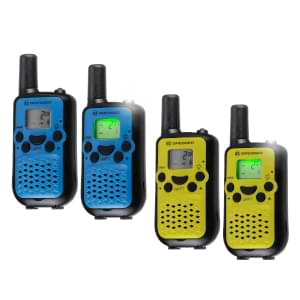You are here: / Bresser Junior / Flora

Let’s go with Flora and discover nature
Flora takes you on her adventures into nature. She will teach you everything you need to know about binoculars, give you some observation tips and tell you some exciting information about her world. No need to be bored, with beautiful colouring pictures and great games to enjoy!
Fancy an adventure?
Table of contents
Binoculars
 People wanted to get close to things far away a long time ago. In fact, the first binoculars were made more than 400 years ago. But what exactly are binoculars? And what do the mysterious numbers on them actually mean?
People wanted to get close to things far away a long time ago. In fact, the first binoculars were made more than 400 years ago. But what exactly are binoculars? And what do the mysterious numbers on them actually mean?
A pair of binoculars is an optical device that allows you to see things that are far away. With your eyes alone, you would not be able to see them, or only very poorly. Most binoculars look similar on the outside. But, if you look through them, you’ll quickly notice that the same object can look completely different through two different pairs. That’s because they differ in terms of their features. You can see this in the numbers printed on the binoculars. Curious? You can learn more here.
Magnification

An important value for binoculars is their magnification. Some have a magnification of 2x, while others offer 6x, 8x, 10x and, on occasion, even 12x. The number means that you can get 12 times closer than with your eyes alone. So, a bird that is 1200 m away would look the same size as if it were just 100 m away. The higher the magnification, the harder it is to keep the ‘picture’ steady. Another benefit of lower magnification is that the field of vision is larger, so you can see more. This is particularly useful when viewing things that are moving, like animals or footballers on the pitch. A higher magnification allows you to see in greater detail. The magnification is always the first number printed on the pair of binoculars. This model (8x42) has 8x magnification.
Exit pupil

The ‘exit pupil’ is the bright spot that you see when you look into your binoculars from above. The larger the spot, the brighter the picture appears to your eyes. The exit pupil is calculated by dividing the diameter of the lens by the magnification: Lens diameter/magnification = 42/8 = 5.253
Light intensity

In addition to the twilight factor, the light intensity can also help you to calculate the theoretical brightness of your binoculars. This is calculated by dividing the diameter of the lens by the magnification and squaring the result. (Lens diameter/magnification)^2 = (42/8)^2 = 27.56
Interpupillary distance

The interpupillary distance refers to the distance between your eye and the eyepiece when looking through the binoculars. If you wear glasses, your eye will be farther away from the eyepiece than if you don’t. All of our binoculars have adjustable eyecups so that the distance fits perfectly, even if you’re wearing glasses, so that you can see everything. You can either turn them down or screw them out.
Dioptre adjustment

Many binoculars, particularly more expensive ones, allow you to rotate the right eyepiece. This allows you to compensate for different levels of vision between the eyes.
Lens diameter

So what about the second number? Easy – it refers to the diameter of the lens in millimetres. That’s the width of each lens at the front of your binoculars. The larger the diameter, the more light will enter the glass and reach your eye, so that the picture will be brighter. With these binoculars, the diameter is 42 mm, hence the numbers 8x42 printed on the binoculars.
Pupil distance

The pupil distance is the distance between the two exit pupils. This distance needs to be adjusted individually to the person using the binoculars. To adjust the binoculars to your eyes, bend the binoculars in the middle. How will you know that the distance is correct? Easy – you should only be able to see the picture through the binoculars inside a single circle.
Twilight factor

If you think you might want to use your binoculars at dusk, right before it gets dark, you should check the twilight factor for an idea of how they will perform. The larger the number, the better you will be able to see with the binoculars, even in poor lighting conditions. With a little mathematic practice, you can calculate this figure yourself. Take the magnification and multiply by the diameter of the lens, then determine the square root of that number. Square root (magnification x lens diameter) = square root (8 x 42) = 18.33
Field of vision

The field of vision is the number of metres in width that you can see at a distance of 1000 metres. A field of vision of 101 m/1000 m means that at a distance of 1000 m, you will be able to see a width of 101 m. Sometimes this value is given in degrees instead of metres. With that, you can easily calculate the metre figure – 1° is equivalent to 17.5 metres. So, multiply the degree number by 17.5 to give the number of metres. The following is an example for a field of vision of 6°: Number of degrees x 17.5 = 6 x 17.5 = 105 metres at 1000 metres
For advanced
Coating
When light enters binoculars, ‘scattered light’ can occur. This can significantly reduce the contrast in the picture. To stop this from happening, the lenses have a coating. This ensures that more light enters the binoculars and that reflections are minimised.
The different coating levels are:
a) Partial coating
With this coating, the outer lens and eyepiece lenses are coated.
b) Full coating
With full coating, all glass surfaces that face the light (in the beam path) are vaporised once.
c) Multiple coating
With multiple coating, all glass surfaces that face the light are coated (as with full coating), but there is an additional layer on the outer lenses and eyepiece lenses.
d) Full multiple coating
With full multiple coating, all glass surfaces of the prisms and lenses that face the light are coated at least three times. Lenses with no coating at all allow only around 50 to 60% of the light through, fully coated lenses around 70 to 75% of the light and fully multiple coated lenses as much as 95% of the light.
Glass material
Various glass materials available for the lenses of binoculars, such as Bk-7 or BaK-4. We are particularly careful when it comes to models for children and always use plastic lenses so that children can explore their environment safely.
Binocular types
Our garden birds
Save the bees
Scientists have found that insect populations are decreasing year on year, and that’s a major problem! Insects are important and play a useful role in our ecosystem. They pollinate our flowers, for example, and ensure that our plant species are preserved and that your apple tree grows apples. Insects also eat smaller pests, such as aphids and mites, helping to ensure bigger harvests. But, those insects are also a source of food for many birds, amphibians, reptiles and mammals.
Pesticides used in agriculture, building on open spaces (‘sealing’ of green spaces) and climate change are all contributing to a decrease in the number of insects.
Flora is keen to do something about it and to save our insects. To do this, she is building an insect hotel in her garden. Would you like to help her? Here are the assembly instructions:
Build an insect hotel
Instructions for assembling an insect hotel with an old food can:
An old food can
Small bamboo sticks or old dry branches
Cotton (e.g. cotton pads)
A saw and wood drill bit
String
1. Start by looking for something tasty in a can!
2. Enjoy your meal and rinse the can thoroughly
3. Consider whether to cut short or long sticks
4. If using long bamboo sticks, remove the bottom of the food can with a can opener; if using short bamboo sticks, leave the bottom in place
5. Cut the bamboo sticks or hollow branches into longer or shorter pieces, e.g. with a hacksaw
6. If the branches are not hollow, drill into the inside of each stick with a wood drill bit
7. If the branches are completely hollow, insert some cotton into the end as bees prefer things to be windproof
8. Place all of the branches and sticks into the food can until they are tight and cannot fall out
9. Finally, find somewhere dry to hang your insect hotel using the string – make sure that it’s facing south

Build an insect hotel

Instructions for building an insect hotel with a log:
Min. 20 cm thick tree discs
Always hardwood (elder, beech, ash, birch), no coniferous wood
Wood must be well seasoned (dried)
Wood drill bit (3 - 6 mm) and power drill
1. Drill into the log as vertically as possible
2. Alternate the different drill bit sizes when drilling holes so that there are holes for as many different insects as possible
3. Finally, find somewhere dry to place your insect hotel – make sure that it’s facing south


Flora’s tip:
Make sure that your wood sticks and branches have smooth edges, otherwise the bees can injure themselves.
Please ask an adult to help you so that you don’t hurt yourself.
Create a wild flower meadow
You can do even more for the insects, bees and birds in your environment. One thing you could do is plant a wild flower meadow:
Instructions
1. Start by considering how big you want the wild flower bed to be. That way you can make sure that you get plenty of seeds.
2. For one square metre of ground, you need around 5 - 10 g of seeds.
3. You can buy individual seeds or buy a ready-made mix, e.g. from a gardener.
4. The next step is to loosen up the soil a little and scatter the seeds evenly.
5. Go over the soil with a roller or press the seeds into the ground with a board.
6. Make sure to keep your seeds moist for 4 - 6 weeks after sowing.
7. Now you just need to wait for the first bees and butterflies to fly in to your wild flower meadow.
Particularly insect-friendly plants
Field poppy
Cornflower
Daisy
Margerite
Red clover
Wild carrot
Soapwort
Trefoil
Cow parsley
Zigzag clover
Yarrow
Particularly insect-friendly plants
Create a wild flower meadow

Build a bird feeder
You will need
One base panel (25x25x2 cm)
Two roof panels (20x25x1 cm)
Four side rails (25x5x1 cm)
Four roof pillars (25x2x2 cm)
Nails
Hammer
Saw
Small roof shingles (if desired)
If desired, linseed oil as a varnish and a brush
Bird food
1. Start by taking the base panel, then nail the four side rails to the outside of the base panel.
2. Cut a 45° angle on one end of each of the four roof pillars.
3. Place each roof pillar in a corner of the floor panel, nail them in place from below and from the side through the side rails.
5. Position the roof panels on the roof pillars at a 90° angle.
6. Nail the roof panels to the roof pillars.
7. If you want to, you can bond small shingles to the roof panel.
8. You can now brush your bird feeder with some linseed oil to give it some protection from the rain.
9. Now fill your bird feeder with plenty of bird food and put it in a nice spot.
You will soon find a variety of different birds visiting your bird feeder! Watch them with your binoculars, and have fun!
Instructions for building a bird feeder


 Deutsch
Deutsch
 English
English
 Francais
Francais
 Español
Español
 Italiano
Italiano
 Nederlands
Nederlands
 Polski
Polski





















